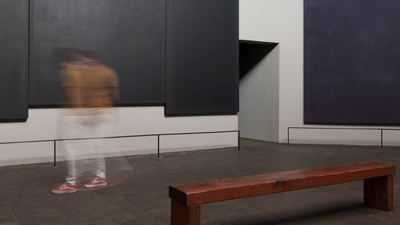At 50, Rothko Chapel Is ‘Mesmerizing’ Sacred Space Houstonians Shouldn’t Take for Granted
ISN'T IT INTERESTING that when you live in a city all of your life, you are less likely to spend time visiting the historical sites there.
If you're like me, you'll travel across the country, or the world for that matter, and make sure to include certain museums or sites in your itinerary. But you forget about what's in your backyard, leaving it for tourists.
All the while, here in Houston we have one of the most sacred spaces on the globe, created by one of the preeminent artists of the 20th century generation of Abstract Impressionist artists — and after visiting it again yesterday, I am mesmerized by its power, in all of its simplistic glory.
I had the privilege of spending time with Christopher Rothko at the magnificent Rothko Chapel, whose father Mark was not only responsible for creating the paintings himself, but was instrumental in the actual building design 50 years ago. Christopher was in town from New York promoting the chapel's 50th anniversary celebration last weekend — and the journey of its recent restoration. The series of events included conversations, a book release and a community commemorative celebration reflecting on the last half century of the Rothko Chapel's work and mission.
The mission, "to create opportunities for spiritual growth and dialogue that illuminate our shared humanity and inspire action leading to a world in which all are treated with dignity and respect," seems more relevant than ever at this time in history. Yet it reminds us that even 50 years ago, when the Broken Obelisk sculpture outside of the chapel was dedicated to Martin Luther King by the great arts patrons John and Dominique de Menils, even then, humanity was in need of opportunities for spiritual growth and action to inspire respect.
There was something mystical about my visit to the Rothko Chapel this time. Talking with the charming son of the late and brilliant artist brought a spiritually symbolic aspect into the experience. And the more that time passed inside the chapel, replete after its renovations with architectural and lighting improvements intended to enhance the visitor's experience, the more at peace I felt — and the more I my soul drifted to the contemplation of humanity and love.
Coupled with the renovations that have reimagined the sacred space, it felt like another experience than I have had in the past.
I can't explain it. I simply experienced it.
Rothko's works are known to express everything from "joy and ecstasy to grief and depression," it's been observed by art experts. It's no secret that the last years of the artist's life were filled with depression, to the point that he took his own life in his New York studio and was never able to see his masterpiece come to fruition. Looking at the dark and ominous paintings, with the thin washes of color, on arrival, I could immediately feel his pain and oppression. But within minutes, as my eyes began to grow accustomed to the dim room through the architecturally brilliant skylight, feelings of peace and blessings and happiness came over me.
The visionary founders of the Rothko Chapel, the de Menils, have left us with a wonder in the heart of our great city. They were strong believers "in the power of dialogue, spirituality, and the transformative power of art." The Rothko Chapel is the crown jewel of their gifts, and I implore you to partake in the experience of spending time inside. It will open your heart in the most glorious way.
- Aspen-Based Artist Opens Long-Awaited Gallery in Upper Kirby - Houston CityBook ›
- A Sneak Peak of the Sold-Out Concerts Celebrating Rothko Chapel’s 50th - Houston CityBook ›
- Two Posh Purveyors Bling in the Season with a Series of Sizzling VIP Soirees - Houston CityBook ›
- Making ‘Room for Everybody,’ Gretchen Parlato Brings Her Multi-Genre Brand of Jazz to Houston - Houston CityBook ›
- Cheech Marin and Other Legends Toast Rothko Chapel and the Power of Art at Lively 'Inspirit' Fundraiser - Houston CityBook ›
